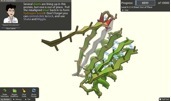Novices Level Up to Experts with FoldIt (Zoran Popovic)
In work analogous to Liberating Structures, novices are outperforming experts in biology.
Can novices unravel one of the most complex problems in biological science? The answer is “yes” if they are attracted to solving puzzles and learn the basic rules of interaction.
Proteins are catalysts and messenger “workhorses” throughout our bodies. Thousands of varieties help us heal, break down food, and grow. An entangled structure with multiple folds determines how a protein functions and fits in with other proteins.
Figuring out how a protein folds helps us understand disease (e.g. cancer, AIDS, Alzheimers) while advancing therapies and cures. Unraveling the folds is one of the tough and expensive problems in biological science. Human pattern recognition and intuition make people more effective than computers-only in puzzling out the folds.
 Enter FoldIt, a free computer game. May 8th 2008 FoldIt was launched and quickly attracted players. Soon after, teams formed that engaged scientists and novices in seriously fun head-to-head competition. By 2011 the combined intelligence of over 200,000 people has contributed to solving protein puzzles (with participants receiving attribution in an article published by the journal Nature).* Experts and novices urged each other on.
Enter FoldIt, a free computer game. May 8th 2008 FoldIt was launched and quickly attracted players. Soon after, teams formed that engaged scientists and novices in seriously fun head-to-head competition. By 2011 the combined intelligence of over 200,000 people has contributed to solving protein puzzles (with participants receiving attribution in an article published by the journal Nature).* Experts and novices urged each other on.
After learning the simple rules or minimum specifications (e.g. opposite charges attract, proteins fold into the lowest energy state) of protein physics in early rounds of the game, novices become citizen scientists. They use a cursor to manipulate a chain of amino acids into its optimum shape. For a specific challenge, your folds are compared to what is known and what is unknown. There are few hints because biologists and the game designers at the University of Washington do not know the answers.
A gamer “at play” can unravel mysteries of proteins without a known structure. Moreover, new combinations with therapeutic properties can emerge from the playful competition and collaboration. Designs emerging out of play may solve serious chronic disease.
Most interesting are the results generated by novice non-scientists and experienced scientists. FoldIt co-designer professor Zoran Popovic says, “The experts had 15 years to understand how a protein causing AIDS in rhesus monkeys folds. Novices found a solution in a few weeks.”**
Dr. Popovic is the Director of the Center for Game Science at the University of Washington.
Experts have been surprised by the speed and intuition cultivated in FoldIt gamers. “At the start,” says Dr. Popovic, “many did not think FoldIt would amount to much. Now, randomized trials demonstrate that novices can outperform scientists on complex challenges. Some of our post-docs thought only they could develop the ‘secret sauce’ through rigorous experiments.”
Interestingly, Dr. Popovic is applying to same approach to elementary school math education. Making complex puzzles seriously fun to unravel is attracting attention in other domains.
Parallels with Liberating Structures
The collective intelligence unleashed by FoldIT begs the question: how many organizational challenges can be solved by inviting and including everyone in seriously playful exploration? Is there a large population of innovation novices poised to become expert contributors?
Akin to FoldIT, LS make it easy and fun to:
- learn the minimum specs of creative and productive interaction
- outperform and complement the work of experts
- speed up and enrich the discovery process as a community
- find surprising individual talent where it is least expected
- frame questions in a way that attracts people to complex puzzles
- tap highly distributed talents without regard to formal rank in the hierarchy
- collaborate and compete while working on a worthy goal
- give credit for advancements to everyone who contributes
[Read LS FAQs to see how novices quickly learn to become expert contributors]
FoldIt and LS make crowdsourcing a gamechanger. Everyone is invited to contribute and innovate.
* Predicting protein structures with a multiplayer online game," with Seth Cooper, Firas Khatib, Adrien Treuille, Janos Barbero, Jeehyung Lee, Michael Beenen, Andrew Leaver-Fay, David Baker and Foldit players, in Nature 446 p. 756-760 (05 August 2010).
** Advance Online Publication (AOP) in Nature Structural & Molecular Biology
